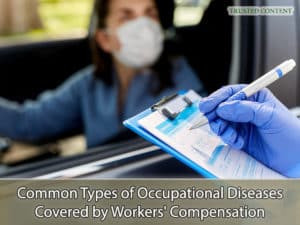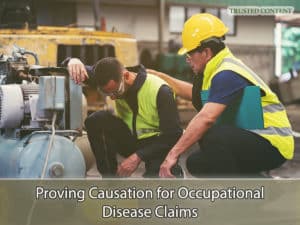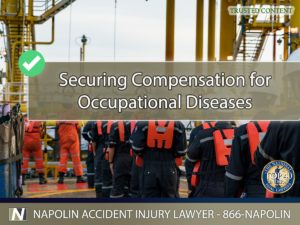Securing Compensation for Occupational Diseases in Ontario, California
Workers’ compensation in California provides crucial protection for employees who suffer injuries or illnesses due to their occupation. This includes coverage for a range of occupational diseases that can significantly impact a worker’s health and livelihood. Securing compensation for these conditions requires navigating a complex legal landscape, which can be challenging without proper legal representation. With almost 10 million workers in southern California alone, many are exposed to occupational hazards every day. Despite the strong legal protections available, many workers remain unaware of their rights, resulting in unclaimed benefits and untreated conditions. Napolin Accident Injury Lawyer offers comprehensive legal assistance to help injured workers understand their rights and obtain the compensation they deserve.
Understanding Occupational Diseases in California
California law defines occupational diseases as illnesses resulting directly from a worker’s job duties or the specific conditions of their work environment. Examples include respiratory illnesses from inhaling toxic substances or repetitive stress injuries caused by continuous manual labor. Distinguishing between occupational and non-occupational diseases is vital for claims. Occupational diseases stem directly from job-related activities, while non-occupational diseases arise from unrelated factors. For instance, asthma triggered by workplace allergens would be considered occupational, while asthma caused by genetic factors or smoking would not.
California Labor Code Sections 3208 and 3208.1 establish that a disease qualifies for workers’ compensation if it’s directly traceable to specific working conditions. However, conditions like the flu or common cold generally don’t qualify unless the workplace significantly increases exposure risks. Moreover, occupational diseases can also include pre-existing conditions aggravated by workplace hazards, such as chronic bronchitis worsened by industrial fumes. Navigating these legal distinctions requires thorough understanding and often, medical expertise.
Challenges in Proving Causation
Proving causation for occupational diseases is often more complicated than for workplace injuries. Unlike physical injuries, which have immediate and visible effects, many occupational diseases develop slowly over time. To qualify for compensation, workers must demonstrate that their illness directly resulted from their employment. This requires strong medical evidence linking the disease to specific work conditions. For example, a worker seeking compensation for lung disease caused by asbestos exposure must provide clear documentation of exposure levels, duration, and their impact on health.
Additionally, employers and insurance companies often dispute claims, arguing that non-work-related factors contributed to the illness. This is especially common with diseases like cancer or heart disease that have multiple potential causes. Workers must also contend with differing opinions from medical experts, further complicating the claims process. Therefore, obtaining comprehensive medical records, detailed exposure histories, and expert testimonies is crucial to proving causation.

Common Types of Occupational Diseases Covered by California Workers’ Compensation
Common Types of Occupational Diseases Covered by California Workers’ Compensation
Respiratory Illnesses
Respiratory illnesses are among the most common occupational diseases due to widespread exposure to harmful airborne substances in various industries. Occupational asthma, chronic bronchitis, and tuberculosis are linked to exposure to substances like asbestos, dust, or chemicals at the workplace. For instance, asbestos exposure is prevalent in construction, leading to asbestos-related lung diseases such as asbestosis and mesothelioma. Similarly, coal miners are at risk of developing pneumoconiosis, commonly known as “black lung disease.”
Moreover, workers in agriculture, textiles, and manufacturing are often exposed to organic dust, which can cause hypersensitivity pneumonitis, a condition marked by lung inflammation. Chronic bronchitis and emphysema, both part of chronic obstructive pulmonary disease (COPD), are also linked to prolonged exposure to industrial pollutants and fumes. Protecting workers from these illnesses requires strict adherence to safety standards, regular health screenings, and proper protective equipment.
Repetitive Stress Injuries
Repetitive stress injuries (RSIs) occur due to continuous, repetitive motions in tasks like typing or assembly line work. Carpal tunnel syndrome and tennis elbow are two common RSIs that often result from prolonged computer use or manual labor. Carpal tunnel syndrome involves compression of the median nerve in the wrist, causing numbness, tingling, and weakness in the hand. Assembly line workers, typists, and cashiers are particularly susceptible.
Tennis elbow, or lateral epicondylitis, results from repetitive wrist and arm motions, often seen in mechanics, carpenters, and athletes. Another common RSI is tendinitis, inflammation of the tendons due to repetitive use, which can affect various body parts like shoulders, elbows, and wrists. Workers can prevent RSIs through ergonomic adjustments, regular breaks, and exercises that promote flexibility and strength.
Skin Conditions
Prolonged exposure to chemicals, allergens, and other hazardous substances can cause occupational dermatitis, eczema, or skin cancer. Dermatitis is characterized by skin inflammation, rashes, and itching, often triggered by contact with irritants like solvents or cleaning agents. Healthcare workers, hairdressers, and construction workers are particularly vulnerable to contact dermatitis due to their frequent exposure to such substances.
Eczema is a chronic condition that can be aggravated by occupational factors like extreme temperatures, dust, and chemicals. Additionally, workers exposed to ultraviolet (UV) radiation or carcinogenic chemicals may develop skin cancer over time. Protective clothing, regular skin checks, and minimizing direct contact with irritants are essential preventive measures.
Radiation and Toxic Exposure
Exposure to nuclear radiation, asbestos, and other toxic substances can lead to cancer, mesothelioma, and radiation poisoning. Nuclear radiation exposure, though rare, can occur in nuclear power plants, research facilities, and certain medical treatments. Prolonged exposure can cause acute radiation sickness and increase the risk of various cancers.
Asbestos exposure remains a significant concern in older buildings, shipyards, and manufacturing plants. It is directly linked to mesothelioma, a rare and aggressive cancer affecting the lining of the lungs, heart, or abdomen. Workers in chemical plants, mining, and waste disposal are also at risk of exposure to toxic substances like benzene, which can cause leukemia.
Heart Disease
Certain occupations involving high stress or exposure to harmful substances may increase the risk of heart disease. High-stress jobs like emergency services or corporate management can lead to hypertension and heart attacks due to chronic stress. Additionally, exposure to carbon monoxide, tobacco smoke, and industrial chemicals can contribute to cardiovascular diseases.
Studies have shown that long working hours, night shifts, and physically demanding jobs can also negatively affect heart health. Workers in these conditions must adopt healthy lifestyle practices, such as regular exercise and a balanced diet, and seek medical advice for stress management.
Hearing Loss
Continuous exposure to high noise levels, common in manufacturing, construction, and entertainment, can cause occupational hearing loss. Workers may experience temporary or permanent hearing damage depending on the intensity and duration of exposure. Construction workers using jackhammers, factory workers operating heavy machinery, and musicians are at high risk.
Noise-induced hearing loss (NIHL) is preventable through the use of proper hearing protection like earplugs or earmuffs. Employers are required to implement hearing conservation programs in noisy environments, including regular hearing tests and training on protective measures.
COVID-19
Workers in high-risk environments, like healthcare or essential services, may contract COVID-19 due to increased exposure. Healthcare workers, first responders, and grocery store employees have a higher risk of infection due to frequent contact with potentially infected individuals. California law has expanded protections for such workers, making it easier to claim workers’ compensation.

Proving Causation for Occupational Disease Claims
Proving Causation for Occupational Disease Claims
Burden of Proof
To secure compensation, workers must prove their illness arose directly from their job. The burden of proof requires clear medical evidence linking the disease to work conditions. For instance, workers claiming respiratory illness due to asbestos exposure must provide documentation of asbestos presence in the workplace, their exposure levels, and how this directly caused their illness.
Employers and insurers often dispute claims by highlighting alternative causes like lifestyle factors or pre-existing conditions. Therefore, workers must collect comprehensive evidence, including employment records, exposure histories, and expert medical opinions. Having legal representation familiar with occupational disease cases significantly strengthens a worker’s ability to meet this burden.
Specific Work Conditions and Examples
The illness must result from specific conditions in a particular workplace or industry. For example, asbestos exposure in construction workers or repetitive motion injuries in office workers. Some examples include:
Construction Workers and Asbestos Exposure: Asbestos was widely used in construction materials, and workers demolishing old buildings are often exposed to hazardous fibers. Mesothelioma, lung cancer, and asbestosis are common conditions resulting from such exposure.
Healthcare Workers and Tuberculosis: Nurses and doctors treating TB patients in poorly ventilated facilities are at high risk of contracting the disease.
Office Workers and Carpal Tunnel Syndrome: Typing on keyboards without ergonomic adjustments can lead to nerve compression and carpal tunnel syndrome.
Factory Workers and Hearing Loss: Factory workers operating loud machinery like presses and saws can suffer noise-induced hearing loss.
Obtaining Expert Medical Opinions
Expert medical opinions play a crucial role in proving causation. Occupational health specialists can provide detailed exposure histories and link specific working conditions to the illness. They can also offer alternative explanations and challenge employer claims that non-occupational factors caused the disease.
Workers should seek doctors familiar with occupational diseases to ensure accurate diagnosis and comprehensive medical records. Additionally, getting second opinions can help strengthen claims and address potential discrepancies in medical evaluations.
Navigating COVID-19 and Workers’ Compensation
Challenges in Securing COVID-19 Claims
COVID-19 poses unique challenges in workers’ compensation claims due to its widespread nature. Workers must prove their exposure occurred specifically at their workplace, which can be difficult given the virus’s community spread. Additionally, many employers argue that workers could have contracted COVID-19 outside of work.
Exceptions to the Rule
California law allows exceptions where workers face an increased risk compared to the general public or if their workplace is a known COVID-19 hotspot. Workers in high-risk industries like healthcare, law enforcement, and food services are more likely to qualify for these exceptions. For instance, if a healthcare worker contracts COVID-19 after treating infected patients without adequate PPE, they can claim increased risk.
Another exception applies if the immediate cause of the injury is an intervening human agency or instrumentality. For example, if a worker contracts COVID-19 and suffers worse injuries due to forced work continuation, they may secure workers’ compensation.
Legal Assistance for Workers’ Compensation Claims
Securing compensation for occupational diseases requires experienced legal representation. Napolin Accident Injury Lawyer’s team has extensive litigation experience in navigating complex workers’ compensation cases. Our strategies work to ensure injured workers receive the benefits they are owed.
Key Strategies for Securing Benefits
Comprehensive Medical Documentation: Ensure that all medical records clearly link the disease to specific workplace conditions.
Expert Witness Testimonies: Obtain expert opinions from occupational health specialists to establish causation.
Detailed Exposure Histories: Provide comprehensive exposure histories detailing specific hazardous conditions encountered at work.
Countering Employer Claims: Be prepared to counter employer and insurer arguments blaming non-occupational factors.
Navigating Legal Complexities: Seek legal representation to navigate filing deadlines, evidence requirements, and administrative procedures.
The Role of Napolin Accident Injury Lawyer
Napolin Accident Injury Lawyer provides personalized legal assistance tailored to each worker’s specific condition and workplace circumstances. We have a proven track record of winning complex workers’ compensation cases, securing maximum benefits for those injured at work. Our team offers free consultations to evaluate potential claims and provide guidance on the best legal strategies.
Filing Requirements and Deadlines
Key Steps and Documentation
Report the Illness to Your Employer: Immediately inform your employer of your illness, providing as much detail as possible.
Seek Medical Attention and Obtain a Diagnosis: Visit a doctor familiar with occupational diseases and obtain a comprehensive diagnosis.
File a Claim with the California Division of Workers’ Compensation: Complete the required forms and submit them to the Division of Workers’ Compensation.
Provide Medical Evidence Linking the Illness to Work: Include detailed medical records, exposure histories, and expert testimonies.
Consult a Workers’ Compensation Lawyer: Seek legal representation to guide you through the claims process.
Important Deadlines
Workers must file their claim within one year of realizing their illness is work-related. However, if the worker received compensation for the illness within the year, the deadline is extended to five years. Medical evidence is crucial in meeting this deadline, as late claims may be denied.
Additionally, workers must notify their employer within 30 days of learning their illness is work-related. Failure to provide timely notice can result in claim denial or reduced benefits.
The Role of Medical Evidence
Medical evidence is vital in supporting occupational disease claims. Workers should obtain detailed records from doctors specializing in occupational health, including:
- Diagnosis of the specific illness
- Medical history showing no significant non-occupational factors
- Exposure history linking the illness to workplace conditions
- Expert opinions from occupational health specialists
- Having comprehensive medical evidence strengthens claims and ensures injured workers receive fair compensation.

Securing Compensation for Occupational Diseases in Ontario, California
Securing Compensation for Occupational Diseases in Ontario, California
Occupational diseases can have significant impacts on workers and their families. Navigating the complexities of workers’ compensation law can be challenging, especially for those dealing with debilitating illnesses. This is why having experienced legal representation is crucial.
Napolin Accident Injury Lawyer is committed to helping injured workers secure the compensation they deserve. Our team understands the unique challenges of proving occupational disease claims and has extensive litigation experience in California workers’ compensation law.
If you or a loved one has suffered an occupational disease, call us at (909) 962-8415 for a free consultation and secure the benefits you deserve.
